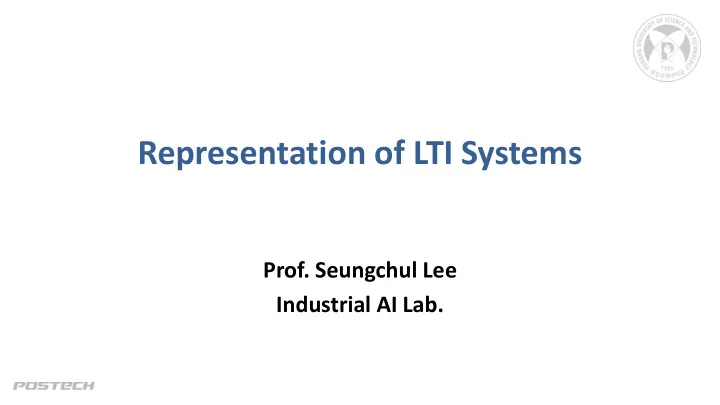

Representation of LTI Systems Prof. Seungchul Lee Industrial AI Lab.
Transfer Function • Equation of motion • Laplace Transform • Block Diagram 2
Example 3
State Space Representation 4
Three Representations of LTI Systems 5
Three Representations of Linear Systems 1) Time domain 2) Frequency domain 3) State space 6
Time and Frequency Domains • In linear system, convolution operation can be converted to product operation through Laplace transform 7
Converting from State Space to a Transfer Function • State Space can be represented: Laplace Transform • Solving for 𝑌(𝑡) in the first equation Laplace transformed • Substituting equation 𝑌(𝑡) into second equation Laplace transformed yields 8
Converting from State Space to a Transfer Function • We call the matrix 𝐷 𝑡𝐽 − 𝐵 −1 𝐶 + 𝐸 the transfer function matrix • Note – The output in time 9
Laplace Transform of Matrix Exponential • Series expansion of 𝐽 − 𝐷 −1 • Series expansion of 𝑡𝐽 − 𝐵 −1 • Inverse Laplace transform of 𝑡𝐽 − 𝐵 −1 10
Laplace Transform of Matrix Exponential 11
Transformation of State-Space • State space representations are not unique because we have a lot of freedom in choosing the state vector. – Selection of the state is quite arbitrary, and not that important • In fact, given one model, we can transform it to another model that is equivalent in terms of its input- output properties • To see this, define model of 𝐻 1 (𝑡) as • Now introduce the new state vector 𝑨 related to the first state 𝑦 through the transformation 𝑦 = 𝑈𝑨 • 𝑈 is an invertible (similarity) transform matrix The new model of 𝐻 1 (𝑡) 12
Same Transfer Function ? • Consider the two transfer functions • Does 𝐻 1 𝑡 = 𝐻 2 (𝑡) ? • So the transfer function is not changed by putting the state-space model through a similarity transformation 13
Decoupled LTI System • If 𝑈 = 𝑇 , transformation to diagonal matrix 14
Converting a Transfer Function to State Space • How to convert the transfer function to state space? • We can redraw block diagram like the below 15
Converting a Transfer Function to State Space • Reverse Laplace transform • Choose state variable: – A convenient way to choose state variables is to choose the output, 𝑧(𝑢) , and its (𝑜 − 1) derivatives as the state variables 16
Converting a Transfer Function to State Space • Draw this into a block diagram 17
MATLAB Implementation 18
Step Response • Start with a step response example • The solution is given: 19
Step Response 20
Step Response 21
Step Response 22
Impulse Response • Now think about the impulse response • The solution is given: 23
Impulse Response 24
Impulse Response 25
Response to a General Input • Response to a general input • The solution is given: 26
Model Conversion in MATLAB 27
State Space ↔ Transfer Function 28
Summary • LTI Systems – In time – In Laplace (or Frequency) – In state space • MATLAB Implementation 29
Recommend
More recommend